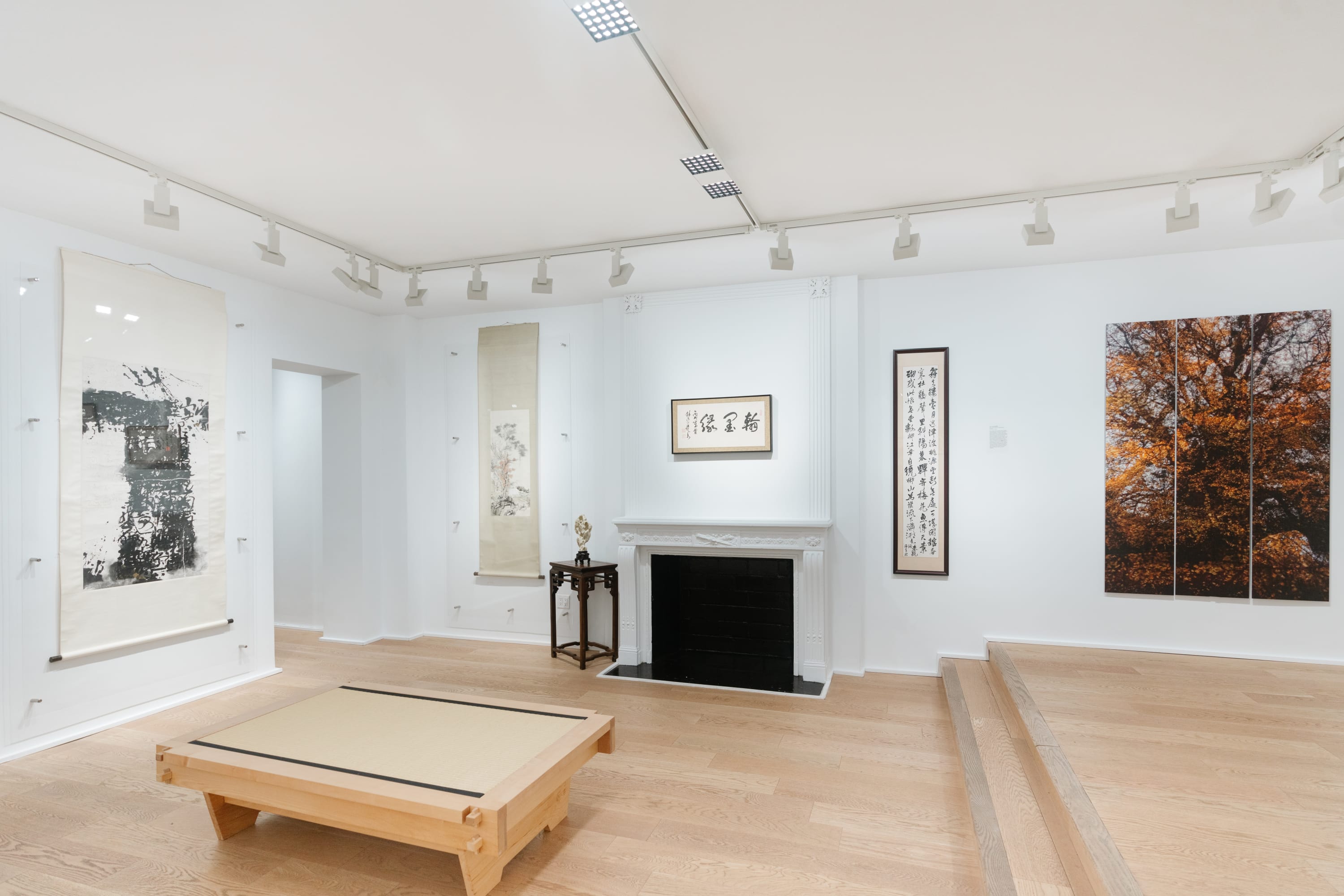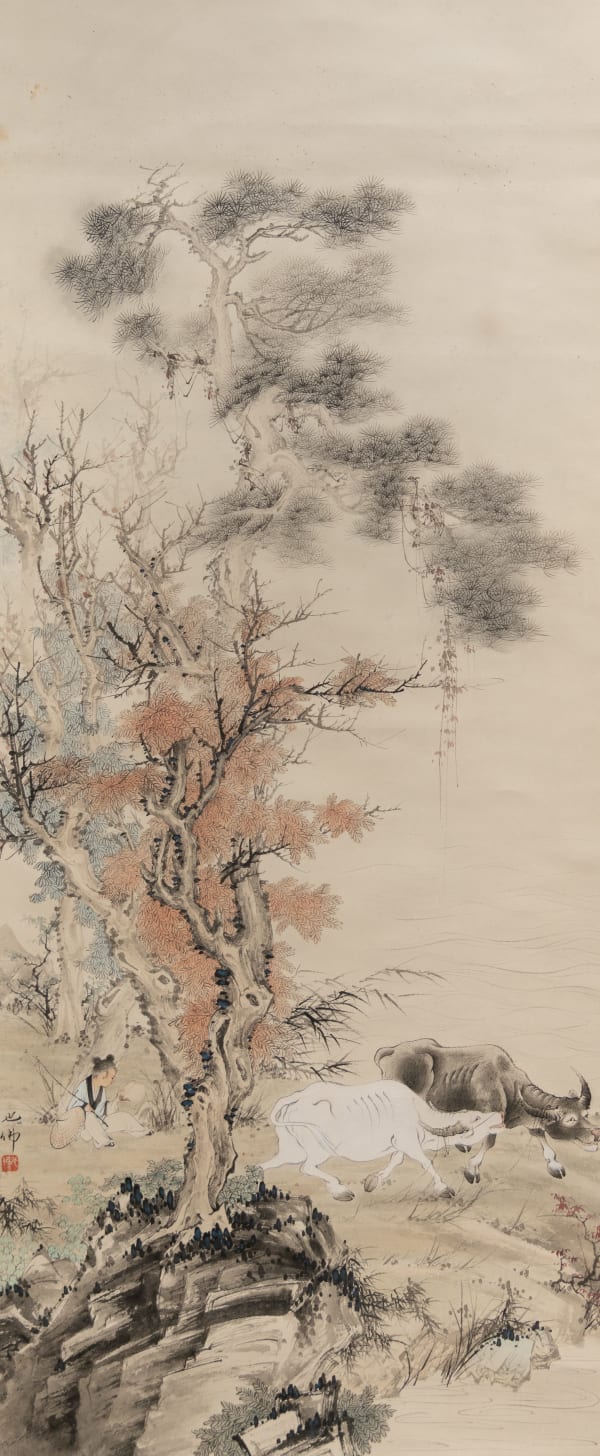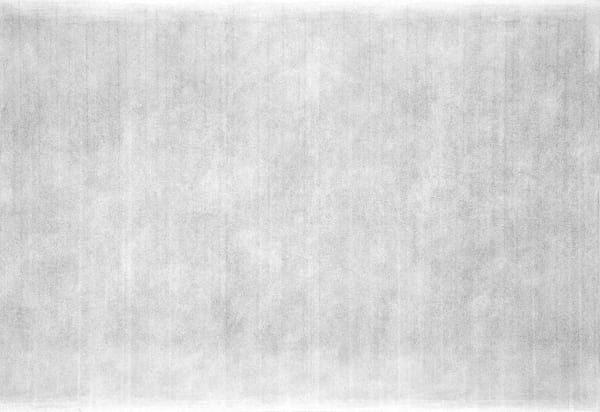-
As autumn deepens, FQM is pleased to present the year-end group exhibition, Ink and Inspiration.
At the heart of East Asian painting and calligraphy is a deep understanding of the “brush,” and inseparable from that is the use of “ink.” Together, brush and ink have given rise to artistic traditions that have evolved over thousands of years and continue to influence the modern world today. This dynamic interplay between simplicity and complexity—depth and breadth—creates endless possibilities, much like the ancient game of Go, where simple rules lead to infinite strategies.
-
-
The theme of this exhibition is drawn from a plaque by Yang Renkai, titled Ink and Inspiration. Yang Renkai was a prominent member of the appraisal team that authenticated Chinese paintings and calligraphy in the early years of the People’s Republic of China. He conducted extensive research on priceless works lost from the Forbidden City during the late Qing dynasty, rediscovering treasures like Along the River During the Qingming Festival. Remarkably, he even pieced together Mi Fu’s masterpiece Poems on the Tiao Creek from scraps of paper.
In 1975, Yang Renkai visited the U.S. to study Chinese paintings and calligraphy in American museums, and he wrote widely about his findings. He also viewed private collections in the U.S., gaining a deep appreciation for how these works were treasured abroad. In 2006, at the age of 91, Yang Renkai created the current work, demonstrating his lifelong dedication to brush and ink. His work serves as a reflection of FQM’s long-standing mission to celebrate these artistic traditions.
-
 This exhibition features works by Huang Junbi (1898-1991) and Hu Yefu (1908-1980), representing traditional approaches to brush and ink. In contrast, we present calligraphic works by C. C. Wang, charting his final two decades of practice in New York City. Wang’s journey unfolds from traditional calligraphy through an experimental phase, and culminates in an abstract style that reflects his transformation from a classical Chinese landscape painter to a contemporary artist attuned to the creative energies of the 1980s and 1990s. Yu Peng (1955-2014) brings a fresh, unconventional approach to brushwork, introducing bold colors and innovative compositions that pushed the boundaries of ink painting at the turn of the 20th century. Chen Danqing (b. 1953), known primarily for his oil paintings, demonstrates a deep respect for traditional calligraphy, with brushwork that recalls the style of Ming dynasty masters. Finally, the collaborative work of Michael Cherney (b. 1969) and Arnold Chang (b. 1954) represents the modern extension of brush and ink into the contemporary art world, where tradition and innovation meet.
This exhibition features works by Huang Junbi (1898-1991) and Hu Yefu (1908-1980), representing traditional approaches to brush and ink. In contrast, we present calligraphic works by C. C. Wang, charting his final two decades of practice in New York City. Wang’s journey unfolds from traditional calligraphy through an experimental phase, and culminates in an abstract style that reflects his transformation from a classical Chinese landscape painter to a contemporary artist attuned to the creative energies of the 1980s and 1990s. Yu Peng (1955-2014) brings a fresh, unconventional approach to brushwork, introducing bold colors and innovative compositions that pushed the boundaries of ink painting at the turn of the 20th century. Chen Danqing (b. 1953), known primarily for his oil paintings, demonstrates a deep respect for traditional calligraphy, with brushwork that recalls the style of Ming dynasty masters. Finally, the collaborative work of Michael Cherney (b. 1969) and Arnold Chang (b. 1954) represents the modern extension of brush and ink into the contemporary art world, where tradition and innovation meet. -
-

-
 Huang Junbi 黄君壁, Flying Waterfall on a Lonely Mountain 空山飛瀑, 1971, ink on paper, mounted for framing.19 1/2 x 29 in | 49.5 x 73.7 cm
Huang Junbi 黄君壁, Flying Waterfall on a Lonely Mountain 空山飛瀑, 1971, ink on paper, mounted for framing.19 1/2 x 29 in | 49.5 x 73.7 cm -
-
 Yu Peng 于彭Tranquil Delight of the Pond 水塘清趣, 1990ink on paper39 1/2 x 27 1/2 in | 100.3 x 69.8 cm
Yu Peng 于彭Tranquil Delight of the Pond 水塘清趣, 1990ink on paper39 1/2 x 27 1/2 in | 100.3 x 69.8 cm -
-
 Hu Yefo, Herd Boy and Buffaloes
Hu Yefo, Herd Boy and Buffaloes -
 Yang Renkai, Ink and Inspiration, 2006
Yang Renkai, Ink and Inspiration, 2006 -
 Chen Danqing, 踏莎行·郴州旅舍
Chen Danqing, 踏莎行·郴州旅舍 -
 Shen Chen, Untitled No.8013-14, 2014
Shen Chen, Untitled No.8013-14, 2014 -
 Shen Chen, Untitled No. 4012-06, 2006
Shen Chen, Untitled No. 4012-06, 2006 -
 Qi Baishi, Standing Tall, Calling Far 立高声远
Qi Baishi, Standing Tall, Calling Far 立高声远 -
 Arnold Chang & Michael Cherney, Ink Bamboo #1, 2015
Arnold Chang & Michael Cherney, Ink Bamboo #1, 2015 -
 Michael Cherney, Shadow Curtains影幔 #9b, Conception and Design: Spring 2018 – Autumn 2018
Michael Cherney, Shadow Curtains影幔 #9b, Conception and Design: Spring 2018 – Autumn 2018 -
 Fung Ming Chip, "海面白上白字 White on white Script", 2008
Fung Ming Chip, "海面白上白字 White on white Script", 2008 -
 Yau Wing Fung, "Mountains and red trees 拟溪山红树图", 2015
Yau Wing Fung, "Mountains and red trees 拟溪山红树图", 2015 -
 Huang Junbi, 空山飛瀑, 1971
Huang Junbi, 空山飛瀑, 1971 -
 C. C. Wang 王季遷 1907-2003, Dreaming Mountains 夢境山水, 1971
C. C. Wang 王季遷 1907-2003, Dreaming Mountains 夢境山水, 1971 -
 C. C. Wang 王季遷 1907-2003, Preface of the Orchid Pavilion in Cursive Script 草書節錄《蘭亭序》, 1994
C. C. Wang 王季遷 1907-2003, Preface of the Orchid Pavilion in Cursive Script 草書節錄《蘭亭序》, 1994 -
 C. C. Wang 王季遷 1907-2003, Ascending Stork Tower in Cursive Script , 1990s
C. C. Wang 王季遷 1907-2003, Ascending Stork Tower in Cursive Script , 1990s -
 C. C. Wang 王季遷 1907-2003, Saying Farewell to Monk Lingche in cursive script, 1990s
C. C. Wang 王季遷 1907-2003, Saying Farewell to Monk Lingche in cursive script, 1990s -
 Wang Fangyu, Eagle, 1996
Wang Fangyu, Eagle, 1996 -
 Wang Tiande, New Chinese Clothes I, 2003
Wang Tiande, New Chinese Clothes I, 2003 -
 Xiao Xun, Admiring Chrysanthemums in the Autumn Mountains 秋山獨賞, 1941
Xiao Xun, Admiring Chrysanthemums in the Autumn Mountains 秋山獨賞, 1941 -
 Yu Peng, 水塘清趣, 1990
Yu Peng, 水塘清趣, 1990 -
 Hu Yefo, Herd Boy and Buffaloes
Hu Yefo, Herd Boy and Buffaloes -
 Fang Xian, Heart Sutra in Clerical Script, 2024
Fang Xian, Heart Sutra in Clerical Script, 2024
-
24 October - 14 December 2024
Join our mailing list
* denotes required fields
We will process the personal data you have supplied to communicate with you in accordance with our Privacy Policy. You can unsubscribe or change your preferences at any time by clicking the link in our emails.


























